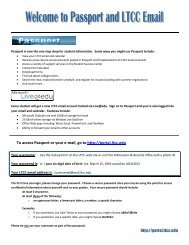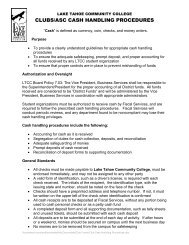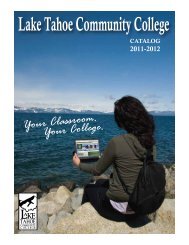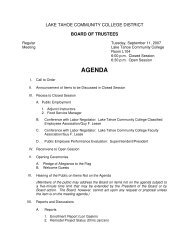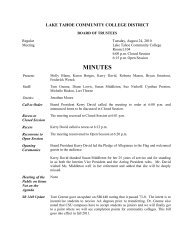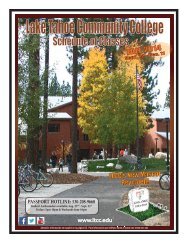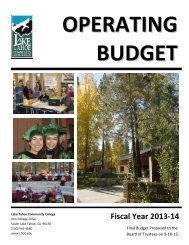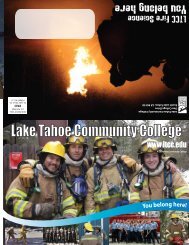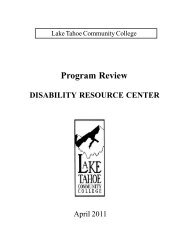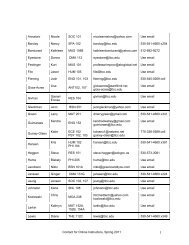View the 2010-2011 Catalog (4 MB) - Lake Tahoe Community College
View the 2010-2011 Catalog (4 MB) - Lake Tahoe Community College
View the 2010-2011 Catalog (4 MB) - Lake Tahoe Community College
- No tags were found...
Create successful ePaper yourself
Turn your PDF publications into a flip-book with our unique Google optimized e-Paper software.
FIRE SCIENCE154LTCC CATALOG <strong>2010</strong>-<strong>2011</strong>FIR 131 SPECIAL TOPICSUnits 1-4This course is designed to meet <strong>the</strong> needs of students for studies inareas of special interest. Topics and credit will vary from quarter toquarter and will be included under this cover title published in <strong>the</strong>schedule for <strong>the</strong> quarter in which <strong>the</strong> course will be offered.Transfers to CSUFIR 132 OCCUPATIONAL WORK EXPERIENCELecture 0, Lab 0, Units 1-6Occupational Work Experience is for students who are employed injobs related to <strong>the</strong>ir educational or occupational goals. This programextends knowledge gained in <strong>the</strong> classroom to <strong>the</strong> workplace, helpsstudents identify new and challenging objectives at work, andencourages professional growth and advancement.Transfers to CSUCOREQUISITE: Students must be available to work or volunteer 4 to 40 hoursper week for an approved business and must have an application on file each quarterenrolled.REPEATABILITY: May be repeated up to a total of twenty-four (24) units, six unitsmaximum per quarter.FIR 133 OCCUPATIONAL WORK EXPERIENCE -INTERNSHIPLecture 0, Lab 0, Units 1-6Occupational Work Experience Internship is supervised placementat a worksite related to <strong>the</strong> student’s educational or occupationalgoals. The program will assist students in acquiring desirable workexperience, attitudes, and awareness of career opportunities in <strong>the</strong>irchosen field of study.Transfers to CSUCOREQUISITE: Students must be available to work or volunteer 4 to 40 hoursper week for an approved business and must have an application on file each quarterenrolled.REPEATABILITY: May be repeated up to a total of twenty-four (24) units, six unitsmaximum per quarter.FIR 153 FIRE HYDRAULICSLecture 4, Lab 0, Units 4Water is <strong>the</strong> most practical and commonly used agent for extinguishingfires. This course covers <strong>the</strong> properties of water and how water affects<strong>the</strong> decisions and actions on <strong>the</strong> fire ground. O<strong>the</strong>r topics coveredinclude understanding fire extinguishment <strong>the</strong>ory as it relates tofoam and water, calculating <strong>the</strong> friction loss in elevation and hoseassemblies, and developing fire stream strategies and tactics on <strong>the</strong> fireground in relation to fire hydraulics.ADVISORY: MAT 152B or MAT 152BB with a grade of “C” or better or equivalent.FIR 161A IN-SERVICE TRAINING FORFIREFIGHTERS, MODULE ALecture 0, Lab 8.25, Units 2.75This course is part one of a four-part sequence designed to update,improve and assess <strong>the</strong> knowledge, skills and abilities of fire servicepersonnel. Topics covered include structure fires, emergency medicalservices, rescue, fire prevention, hazardous materials, and sexualharassment awareness and prevention training.PREREQUISITE: Firefighter I certification through <strong>the</strong> Califiornia State FireMarshal.REPEATABILITY: May be repeated 2 times.FIR 161B IN-SERVICE TRAINING FORFIREFIGHTERS, MODULE BLecture 0, Lab 16.75, Units 5.5This course is part two of a four-part sequence designed to update,improve and assess <strong>the</strong> knowledge, skills and abilities of fire servicepersonnel. Topics covered include structure fires, emergency medicalservices, rescue, fire prevention, hazardous materials, and emergencyscene safety.PREREQUISITE: Firefighter I certification through <strong>the</strong> Califiornia State FireMarshal.REPEATABILITY: May be repeated 2 times.FIR 161C IN-SERVICE TRAINING FORFIREFIGHTERS, MODULE CLecture 0, Lab 25, Units 8.25This course is part three of a four-part sequence designed toupdate, improve and assess <strong>the</strong> knowledge, skills and abilities of fireservice personnel. Topics covered include structure fires, wildlandfires, emergency medical services, rescue, fire prevention, hazardousmaterials, and prevention of back injuries.PREREQUISITE: Firefighter I certification through <strong>the</strong> Califiornia State FireMarshal.REPEATABILITY: May be repeated 2 times.FIR 161D IN-SERVICE TRAINING FORFIREFIGHTERS, MODULE DLecture 0, Lab 33.25, Units 11This course is part four of a four-part sequence designed to update,improve and assess <strong>the</strong> knowledge, skills and abilities of fire servicepersonnel. Topics covered include structure fires, wildland fires,emergency medical services, rescue, fire prevention, hazardousmaterials, weapons of mass destruction, and driver/operator training.PREREQUISITE: Firefighter I certification through <strong>the</strong> Califiornia State FireMarshal.REPEATABILITY: May be repeated 2 times.FIR 167 WILDLAND FIRE SAFETY AND HANDCREW OPERATIONS (I-100, L-180, S-130, S-190)Lecture 3.25, Lab .75, Units 3.5This is a comprehensive course in <strong>the</strong> safety aspects of fightingwildland fires and <strong>the</strong> methods and procedures for hand crews,including instruction in specialized equipment, physical fitness, andfire behavior and suppression. Backfire, burnout procedures and lineconstruction will also be covered. This course includes a field exerciseand successful completion results in a certificate from <strong>the</strong> NationalWildfire Coordinating Group (NWCG).FIR 170A LAKE TAHOE BASIN FIRE ACADEMY,PART 1Lecture 8.75, Lab 5.75, Units 10.75This course is part one of a three-part sequence which culminates in<strong>the</strong> instructional requirement for Firefighter I certification through<strong>the</strong> California State Fire Marshal's office. Instruction includes fireorganization and responsibility, cultural diversity, safety, use of selfcontainedbreathing apparatus, fire service apparatus and equipmentoperation, hose and nozzles, ladders, ropes and knots, incidentcommand system, and physical conditioning. This is a physicallydemanding course and <strong>the</strong> curriculum conforms to standards forcertification by <strong>the</strong> California State Board of Fire Services.ADVISORY: Students are advised that this is a physically demanding course. A healthclearance is required.



